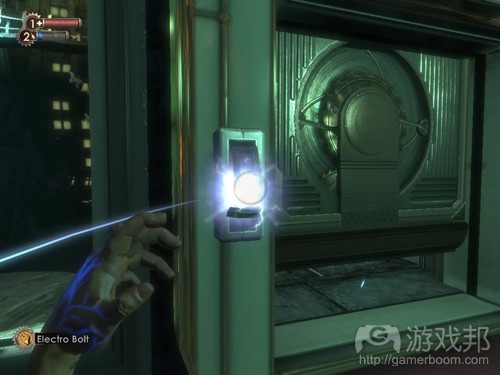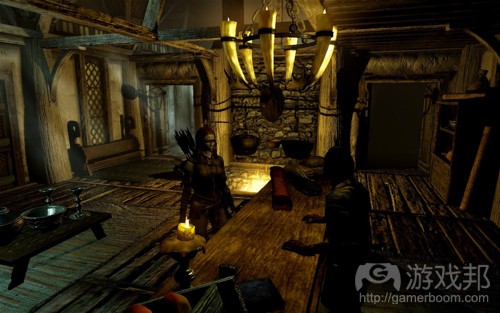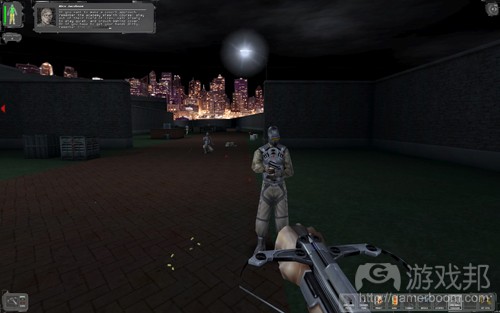关卡设计不应过度追求细节和现实感
作者:Eric Schwarz
最近我一直在玩一些早前的游戏,如《骇客任务》,《Thief》,《网络骑兵2》,《无冬之夜2》等非常有吸引力的游戏。而今天,当我再次回到一些现代游戏中时,我却发现自己撞上了一堵“精神墙”。
特别是这堵“精神墙”上还布满了各种细节。很明显这些新游戏中具有非常生动的图像变化,但是玩家却发现自己很难去适应这种新游戏。虽然早前的游戏加简单(这主要是因为技术局限性所致),但是我却认为当前的美工人员或关卡设计师应该从中学到一些重要的内容。
易读性
关卡设计并不只是关于创造好看的环境或让玩家在一个关卡中面对更加赏心悦目的景象——其基本原理应该是创造出玩家易懂的空间。也就是让玩家能够一眼就理解的内容。而这实际上指的是什么呢?
关卡必须足够突出。设计师必须将游戏目标及重要目标放置在显眼的地方,让大多数玩家都不会轻易错过这些内容。游戏可以利用灯光,颜色,仰角等元素去突出所有重要游戏目标。
关卡必须容易理解。特别是当游戏环境突出了各种小道具和互动对象时,设计师更需要确保玩家在面对新的情境时能够马上就清楚自己面临何种目标。如果玩家不知道自己正在做什么或者如何做某事,那么他们很快便会出现挫败感。最优秀的关卡设计总是能够有效地模拟人们所熟悉的情形。基于经验我们便知道一栋建筑物的地板是如何陈列的,每个城市的街区是如何纵横交错地钩织在一起。而偏离常规的关卡则很容易让玩家误解,因为他们不得不涉及一个全新的领域,并且有可能这一新领域的布局与他们所了解的空间截然不同。
这些并不是创造游戏关卡并的精确的标准——很多开发者喜欢故意打破标准而疑惑或误导玩家。就像Valve便总是在他们的游戏中玩这小把戏,特别是在《求生之路》系列中,故意创造一些狭窄,混乱且难以一眼看穿的空间去阻碍玩家的前行并让他们更容易遭受攻击。恐怖游戏中也总是为了欺骗玩家或创造出超自然感而出现各种偏离现实世界的内容。但是这些类型的游戏属于例外,那些不能带来多少乐趣但却一味地误导玩家的游戏才是真正令人反感的。
视觉语言
大多数游戏,特别是那些定义明确且具有与众不同图像风格的游戏总是存在一些统一的视觉语言,能够贯穿游戏而引导玩家玩游戏并使用用户界面。优秀美术指导的关键并不在于创造出非常华丽的视觉效果,而在于这种视觉效果能够帮助玩家更好地理解游戏玩法,并推动着他们更顺利地前行。
创造视觉语言其实并不困难。例如大多数游戏会在整个用户界面中使用一致的字体,并且在界面上使用相同颜色的文本或相同的图标,从而让玩家更好地做出辨认。真正优秀的界面能让玩家在玩了一会的游戏后拥有模式识别感和记忆感。
统一的视觉语言不仅能够有效地扩展用户界面,同时,也是我们经常忽视的一点,它能够创造一个关卡图像的画板,设计师不仅能够反复利用这一画板,玩家也能够时常将其当作参考。就像我们可以使用不同的颜色去凸显那些难以应付的敌人一样,利用视觉效果去区分那些不够明显的互动元素能够帮助玩家更好地做出瞬间决定。
《生化奇兵》的关卡艺术便延伸至一些很平凡的事物中(如门和开关等),以此引导玩家前进并确保他们能够立即理解任何关卡。
这是什么意思?让我们以《生化奇兵》为例,这款游戏拥有上一代游戏中最出名也是最明确的美术风格。通过使用华丽的灯光照明,像素渲染以及装饰艺术风格,《生化奇兵》在视觉方向上取得了巨大的成功,这同时也是因为不管是在敌人设计还是最小的环境提示和细节设计上,他们都始终坚持一致性。
在《生化奇兵》中,每个游戏元素(不管它是以游戏机制为核心还是只是一个附带的环境道具)都拥有一至两个不同的外观。一般情况下游戏只有两扇门——一扇垂直的大金属门,象征着不同关卡的界限;与一扇水平的小门象征着个人空间等较小的领域。而关卡间的过渡(被不同加载区所分割)则取决于一个巨大的气闸。例如游戏会明显地突出地面上用于电击敌人的水,让玩家从远处就能够看到它。
《生化奇兵》拥有1百多扇不同类型的门,那么是否每扇门都能与每个特定位置匹配在一起?当然了,除此之外它还提供了各种牌子的弹药。游戏所突出的细节和现实主义自然非常吸引人——但是通过限制关卡美工使用调色板,Irrational Games不只创造出了游戏机制的直接视觉效果,同时还满足了玩家想要使用这些机制的需求。当你执行了一个行动并与一个目标进行多次互动后,这便变成了第二天性——游戏的主要目标也将变成是解决问题而不只是向前进了。
细节的危险
当我们在玩像《Thief》和《骇客任务》等早前游戏时,我们便马上能够感受到它们的易读性。就像《Thief》中踩上去会发出噪音的瓷砖便明显区别于柔软安静的地毯式地面。在《骇客任务》中,通风管既能够推动策略性游戏玩法也能够帮助玩家通向安全区域,并也总是呈现出相同的纹理。即使是在今天,简单的视觉效果也仍然具有非常棒的效果,因为玩家总是能够很容易解这些内容;并且因为关卡的清晰性,侧重性和一致性,游戏中也很少会出现被误解的情况。
就像我之前所说的,今天我重新开始玩一些现代游戏。第一款便是《上古卷轴V:天际》。尽管我过去在这个游戏系列中投入了1百个小时,但却仍然需要花大把的时间去适应这款游戏。因为游戏中布满了密密麻麻的植被,所以玩家很难在游戏世界中行走。光是识别环境中哪些对象是互动的,哪些值得最先交互等任务就耗费了我大把的精力了。挑选敌人进行战斗不再是关于寻找一些形状,动画和路线类似的对象,而更像是搜索对象的移动,然后确定来源的过程。
(虽然《天际》等游戏的视觉效果总是让人印象深刻,但是因为玩家很难一眼就找到自己想要的目标,所以这种视觉效果也显得较为杂乱。)
虽然我可以在1个小时内便熟悉游戏,但是游戏所缺乏的易读性却大大破坏了游戏玩法。《天际》中贯穿着各种各样的情境,,但是玩家在一个特定任务中前进的唯一方法则是抢夺一个特定的金库或阅读一本特定的书籍,或杀死一个特定的NPC——如果没有漂浮于重要事物上方的任务标记,游戏根本不可能直观地告知玩家该如何在游戏中前进。这些辅助道具的存在并不是为了说明玩家有多愚蠢甚至不清楚如何前进而完成游戏——而是因为唯一能够引导玩家在《天际》中前进的人只有最先创造出这些内容的开发者。
我还玩了《使命召唤4:现代战争》(算是多人游戏),并且我也很快就发现它与《虚幻竞技场》(游戏邦注:Epic Games旗下的一款单人射击游戏)具有很大的区别。《使命召唤》的关卡非常单调且乏味,这让玩家很难一眼区分不同领域(尽管在续集游戏中得到了改善)。很多场景中充斥着各种杂乱的对象和植被,这让玩家很难在此挑选个体玩家。各个关卡中的爆破,烟雾和火焰等效果也混淆了玩家的视线,导致玩家看不清前进路线并忽视了一些重要信息。
(《骇客任务》等早前游戏的视觉效果便非常简单,但却能够清晰地诠释游戏环境和场景。)
当然这并不是件坏事,特别是当《使命召唤》有意强调这种现实性时——游戏故意加大了目标探测的难度,并且创造了一个让玩家很难辨别事物的混乱战场,只是因为设计师希望能够复制现实战场的状况。《使命召唤》中的挑战不只是关于瞄准和射击,玩家还需要想办法穿越硝烟弥漫的战场并找到自己的目标。
即使如此我也发现自己非常依赖于视觉辅助工具。当我们瞄准敌人时如果未出现一个小小的“X”,我们便很难判断自己到底射中了没有(除非敌人最后死了)。如果在每个团队成员头上未用彩色字体标记他们的名字,我们便无法区分所有带着头盔身穿黑衣并佩带着枪支的成员。如果屏幕上未出现手榴弹指示器或在周围爆破手榴弹时未出现的“ping”声,我们便很难避开这些炸弹。不真实的内容虽然不具有现实性,但是至少让我们能够区分不同玩家!而《使命召唤》中的混乱虽然具有真实性,但它对所有用户界面元素的依赖性表明,过分强调这种细节和现实主义并不利于游戏玩法体验。
结论
就像我之前所提到的,任何事物都不可能一成不变——有时候创造出违背标准设置的例外,创造出一款不具统一性的游戏或“充斥着各种困惑”且难以一眼看穿的游戏也能够取得不错的成绩。尽管在重新玩一些当代游戏时我遇到了各种困难,但是我却绝不是抱怨它们很难操纵或总是会迷惑玩家。
我只想把自己的经历当成是一种警告,为那些基于游戏细节和现实性而创造游戏视觉效果的设计师提供参考意见。已有越来越多游戏中出现了界面辅助元素,并且也越多人开始意识到过分杂乱,繁琐的游戏关卡的不合理性。
如果你不能将一些重要内容与游戏背景区分开来,玩家便很难在游戏中前行,即使是那些带有简单线性关卡和任务目标的肤浅游戏也会让玩家感觉到杂乱与压力,因为它违背了游戏一开始所设定的自由玩法。(本文为游戏邦/gamerboom.com编译,拒绝任何不保留版权的转载,如需转载请联系:游戏邦)
How Much is Too Much Detail?
by Eric Schwarz
I’ve been playing quite a few older games recently. Deus Ex, Thief, System Shock 2, Neverwinter Nights 2 and others have captured my attention for many, many reasons. Just today, I tried to go back to a few more modern titles, and found myself running into a mental brick wall.
Specifically, that brick wall was the amount of detail on display. The graphical jump of the newer games was noticeable, certainly, but I found myself surprised at how much re-acclamation I had to do in order to go back to enjoying the newer titles. There’s a certainl simplicity to these older titles, much of it the result of technological constraints, that I think current developers, whether artists or level designers, could learn much from.
Readability
Level design has never just been about creating great-looking environments, or even ones that are fun to engage with on a mechanical level – a fundamental component of it is in creating spaces that are readable for the player. That is, they must be intuitive to understand even at a quick glance. What does this actually mean in practice?
Levels must have strong focal points. Objectives and important objects should be placed in plain sight and difficult to miss for most players. This is pretty standard stuff – lighting, colour, elevation, and more are all capable of highlighting important game objects the player needs to engage with.
Levels must be understood at a glance. Where things tend to break down, especially in games that feature highly-detailed environments with lots of props and interactive objects, is in throwing the player into a new situation and having the goal and the means to achieve it be immediately clear. If we don’t know what we’re doing, or how to do it, a game can quickly become frustrating.
Levels should make use of intuitive extra-game knowledge. The best level designs will often mimic things that we understand in real life. We know, through experience, how an office building floor is laid out, or how a series of city blocks connect to form a grid. A level that deviates from conventions will often be difficult to understand and confusing to engage with, since players aren’t just navigating a new space, but one that directly contradicts everything they know about how that space should be arranged.
Looks amazing! Er… so where am I supposed to go, again?
As usual, these are not hard and fast rules for building levels – many developers intentionally break them, purposely confusing or misleading players. Valve, for example, routinely do this in all of their games, especially the Left 4 Dead series, which purposely creates spaces that are cramped, cluttered, and difficult to read at a glance in order to stall players and leave them vulnerable to attack. Horror titles also frequently create levels which deviate from real-world expectations, in order to trick players or createa surreal sensation. However, these are exceptions, and a game built of nothing but misdirection will grow tedious and annoying.
Visual Language
Most games, especially those with well-defined and distinctive art styles, tend to have consistent visual languages that they use throughout to guide the player both in playing the game and in using its interface. The key to good art direction isn’t usually just creating visuals that look good, but rather visuals that assist the gameplay and provide the player with sensory cues.
A lot of these are very simple things. Most games, for instance, use a consistent font throughout the entire user interface, and will use the same-coloured text or the same icons in that interface to be readily readable by the player – a good interface will usually let a player go on pattern recognition and muscle memory after a minimum amount of time spent with the game.
However, consistent visual language extends well past user interface or other obvious examples – in my opinion, one of the keys to this that is often overlooked is in creating a palette of level artwork that designers can reuse and players can constantly refer to. Just like different colours can be used to outline which enemies are tougher than others, visually separating less obvious interactive game elements also helps players make split-second decisions.
BioShock uses level art, right down to mundane things like doors and switches, to guide the player and make sure each piece of its levels are immediately and intuitively readable.
What do I mean by this? Take BioShock, a game with one of the most renowned and defined art styles to come out in the last generation. Cutting past the pretty lighting, pixel shaders, and art deco styling, BioShock’s visual direction succeeds because it adheres to a degree of consistency that extends from enemy designs all the way to the smallest environmental cues and details.
In BioShock, each gameplay element, whether it’s an object central to the mechanics or an incidental environment prop, has one or at most two different looks. The game, for the most part, has only two doors – large, vertically sliding metal doors that signify the boundaries of different level areas, and smaller, horizontally-sliding doors which signify smaller areas, like individual rooms. The transitions between levels themselves (separated by loading zones) are almost exclusively large airlocks. Water on the floor, useful for electrocuting enemies, always has a strong reflection visible even from a distance.
Could BioShock have had a hundred different types of door, each one perfectly suited to a given location? Of course, and it also could have had dozens of brands of ammo dispensor. The pretense of detail and realism is certainly compelling – but by limiting the palette available to level artists, Irrational Games created a game whose visual style was in direct service of not just the gameplay mechanics, but the needs of players in actually using those mechanics. Once you’ve performed an action, interacted with an object a few times, it becomes second nature – and the key goal of play summarily becomes problem-solving, not mere navigation.
The Perils of Detail
When examining older titles like Thief and Deus Ex, it becomes obvious very quickly that these games are exceptionally readable. A noisy, tiled floor in Thief can immediately be distinguished from a soft, quiet, carpeted floor. In Deus Ex, ventilation ducts, often both enablers for tactical gameplay and safe havens, always use the same texture. The simplicity of the visuals works so well even to this day because they are eminently readable; there is no room for misinterpretation because the levels are clean, focused and consistent.
As I mentioned above, earlier today I went back to a couple of other more modern titles. The first was The Elder Scrolls V: Skyrim. Although I’d put over a hundred hours into the game in the past, it was shocking to me how much time it took for me to get back into the swing of things. Paths through the game world were difficult to read due to the extremely dense vegetation. Discerning which objects in the environment were interactive, and which ones were worth interacting with in the first place took me an extra mental step or two. Picking out enemies to fight was less about looking for familiar shapes, animations and routines, and more about scanning for movement, then focusing in to ascertain the source.
Games like Skyrim are visually impressive, but also visually cluttered to the point where it can be difficult to pick out anything at a glance.
It didn’t take me more than an hour to get used to it – but it does highlight how the lack of a readily readable game world can get in the way of gameplay. There are many, many situations throughout Skyrim where the only way to proceed in a given quest is to loot a certain chest, or read a certain book, or kill a certain NPC – and without the ever-present quest markers hovering over the important things, it’s almost impossible to tell how to make progress in the game in any sort of visually intuitive manner. These assists exist not because players are dumb and too thick-headed and ignorant to figure out where to go to finish the game – they’re there because the only people who could intuitively navigate much of Skyrim are the developers who created the content in the first place.
The other game I went back to was Call of Duty 4: Modern Warfare, for a little bit of multiplayer gaming – and I learned very quickly that it was a far cry from Unreal Tournament. Call of Duty’s levels are mostly drab and monotone, making it very difficult to distinguish one area from another at a glance (though this improved in some of the sequels). Many spots are thick with clutter objects and vegetation, making it very difficult to pick out individual players. The constant stream of explosions, smoke and fire throughout the levels is disorienting and obscures other players, available routes through the level, and other important information.
Older titles like Deus Ex are visually fairly simple, but there is no ambiguity in interpreting its environments or scenarios. No more pixel hunting?! 2000, here I come!
This isn’t necessarily a bad thing, of course, when taking into account the fact that Call of Duty intends a degree of realism compared to some other shooters – target acquisition is intentionally a bit difficult, and the chaos of the battlefield can be hard to understand, precisely because the game’s goal is, to a degree, to replicate the chaos of real warfare. The challenge of Call of Duty doesn’t just come from pointing and shooting, but from being able to cut through all the smoke and fire to understand the battlefield.
Even so, I found myself almost entirely relying on certain visual assists. Without the little “X” that appears when firing at an enemy, it would be nearly impossible to tell you were actually hitting until the enemy was dead. Without the coloured names over team members’ heads, it’d be impossible to tell one black-clad, helmet-wearing man with guns from the next. Without the grenade indicator on-screen and the distinctive “ping” noise one makes as it lands nearby, it’d be almost impossible to dodge them. Unreal might not be realistic, but at least I can tell different players apart from one another! The chaos of Call of Duty may be intentional, true, but the reliance on all these user interface elements to distinguish them highlights that the focus on detail and realism is not necessarily conducive to good gameplay.
Closing Thoughts
As I mentioned earlier, I can’t stress enough that a lot of these things aren’t set in stone – sometimes making exceptions to the standards set, or intentionally creating a game without a degree of consistency, or one that is difficult to read at a glace by “obfuscation through detail”, can actually work really, really well. And, while I might have had trouble getting back into some newer titles, I don’t want to paint a picture that they are difficult to play or confusing by any means.
Rather, I’d like this to be a cautionary message against creating detail in game visuals for the sake of detail, and realism for the sake of realism. The increasing number of interface assists in most titles, coupled with the desire to continually push the bar in creating highly detailed, cluttered, rich game levels, just doesn’t always work.
It might be a simple or even obvious message, but it’s hard to play a game when you can’t differentiate the important bits from the background scenery, and the result is that even (relatively) mechanically shallow games with simple, linear levels and mission objective markers around every corner can still feel cluttered and overwhelming in a way that actively goes against the freedom in gameplay that was engineered in the first place.(source:GAMASUTRA)












































